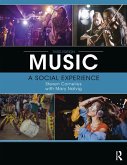New to this edition is a broader selection of musical examples that reflect the values of diversity, equity, and inclusion advocated by North American universities. Eight gateways have been replaced. A timeline of gateways helps students see the book's historical narrative at a glance.
Features
- Values orientation - Diverse, equitable, and inclusive approach to music history.
- All genres of music - Presents all music as worthy of study, including classical, world, popular, and jazz.
- Global scope within a historical narrative - Begins with small-scale forager societies up to the present, with a shifting focus from global to European to American influences.
- Recurring themes - Aesthetics, emotion, social life, links to culture, politics, economics, and technology.
- Modular framework - 60 gateways - each with a listening example - allow flexibility to organize chronologically or by the seven themes.
- Consistent structure - With the same step-by-step format, students learn through repeated practice how to listen and how to think about music.
- Anthology of scores - For those courses that use the textbook in a music history sequence.
Gateways to Understanding Music continues to employ a website to host the audio examples and instructor's resources.
Dieser Download kann aus rechtlichen Gründen nur mit Rechnungsadresse in A, B, BG, CY, CZ, D, DK, EW, E, FIN, F, GR, HR, H, IRL, I, LT, L, LR, M, NL, PL, P, R, S, SLO, SK ausgeliefert werden.









